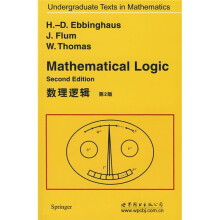数理逻辑(第2版)

目 录内容简介
What is a mathematical proof? How can proofs be justified? Are there limitations to provability? To what extent can machines carry out mathematical proofs?
Only in this century has there been success in obtaining substantial and satisfactory answers. The present book contains a systematic discussion of these results. The investigations are centered around first-order logic. Our first goal is Godels completeness theorem, which shows that the consequence relation coincides with formal provability: By means of a calculus consisting of simple formal inference rules, one can obtain all consequences of a given axiom system (and in particular, imitate all mathematical proofs)
Only in this century has there been success in obtaining substantial and satisfactory answers. The present book contains a systematic discussion of these results. The investigations are centered around first-order logic. Our first goal is Godels completeness theorem, which shows that the consequence relation coincides with formal provability: By means of a calculus consisting of simple formal inference rules, one can obtain all consequences of a given axiom system (and in particular, imitate all mathematical proofs)
比价列表价格走势
1人想要1人拥有
公众号、微信群
 缺书网
缺书网微信公众号
 扫码进群
扫码进群实时获取购书优惠






